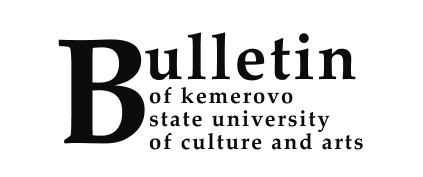PEDAGOGICAL ATTITUDES OF RUSSIAN LAPLAND WITHIN ETHNOCULTURAL TRADITIONS OF KOMI PEOPLE
UDC index:
37:39(=511.132)
DOI:
Article ID in the RSCI:
Article file: Download
Information about authors: Sergeeva Anna Aleksandrovna, PhD in Pedagogy, Associate Professor, Associate Professor of Psychology Department, Murmansk Arctic State University (Murmansk, Russian Federation). E-mail: aser2001@mail.ru
Annotation: The article reveals the relationship between the ethnic group and cultural heritage using Komi people’s national art as an example through the prism of psycho-pedagogical opportunities of epic, decorative and applied, musical and folklore art. Uniqueness and identity, originality and creativity of Arctic region’s ethnic traditions let define their impact on the formation and development of cognitively motivational and emotionalvolitional areas of growing-up generation’s personality. Characteristics of ethnic self-awareness as a special indicator of children’s personality individualization are given, which discover constructive opportunities for learning about the environment, process of socialization, expansion of the worldviews and philosophical visions’ range. Different kinds of ethnic art and creativity within the Kola Peninsula are characterized. The main factor of the ethnocultural processes of Komi people is the integration of Komi Izhemi, Russian and Nenetz people’s culture. Komi culture is expressed by special national symbols: epic tradition identifies two different kinds: Vychegod-Vym ballads, Andizh-Kolvin tales; small folklore forms: fairytales, mysteries, nursery rhymes, hide-andgo-seeks, tongue twisters and proverbs. Traditional family values: reverence of the older family members, help to the younger children, deep respect of the parents are projected on masterpieces of decorative and applied, folklore Komi art. Family techniques of embroidery, dressmaking, doll making and jewellery making, making of utensils and little furniture contribute to development of moral qualities and personality characteristics of a child, familiarize with the formation of life values and priorities’ hierarchy. Ethno-pedagogical and ethno-psychological features are defined, as well as opportunities for traditional art of northern Komi within Russian Lapland, which stimulate the formation of nation-ethnical indulgence, respect and tolerance.
Keywords: ethnicity, ethnical self-awareness, ethnic culture, ethnic art, Izhma Komi, ethnopedagogy.
DOI:
Article ID in the RSCI:
Article file: Download
Information about authors: Sergeeva Anna Aleksandrovna, PhD in Pedagogy, Associate Professor, Associate Professor of Psychology Department, Murmansk Arctic State University (Murmansk, Russian Federation). E-mail: aser2001@mail.ru
Annotation: The article reveals the relationship between the ethnic group and cultural heritage using Komi people’s national art as an example through the prism of psycho-pedagogical opportunities of epic, decorative and applied, musical and folklore art. Uniqueness and identity, originality and creativity of Arctic region’s ethnic traditions let define their impact on the formation and development of cognitively motivational and emotionalvolitional areas of growing-up generation’s personality. Characteristics of ethnic self-awareness as a special indicator of children’s personality individualization are given, which discover constructive opportunities for learning about the environment, process of socialization, expansion of the worldviews and philosophical visions’ range. Different kinds of ethnic art and creativity within the Kola Peninsula are characterized. The main factor of the ethnocultural processes of Komi people is the integration of Komi Izhemi, Russian and Nenetz people’s culture. Komi culture is expressed by special national symbols: epic tradition identifies two different kinds: Vychegod-Vym ballads, Andizh-Kolvin tales; small folklore forms: fairytales, mysteries, nursery rhymes, hide-andgo-seeks, tongue twisters and proverbs. Traditional family values: reverence of the older family members, help to the younger children, deep respect of the parents are projected on masterpieces of decorative and applied, folklore Komi art. Family techniques of embroidery, dressmaking, doll making and jewellery making, making of utensils and little furniture contribute to development of moral qualities and personality characteristics of a child, familiarize with the formation of life values and priorities’ hierarchy. Ethno-pedagogical and ethno-psychological features are defined, as well as opportunities for traditional art of northern Komi within Russian Lapland, which stimulate the formation of nation-ethnical indulgence, respect and tolerance.
Keywords: ethnicity, ethnical self-awareness, ethnic culture, ethnic art, Izhma Komi, ethnopedagogy.
